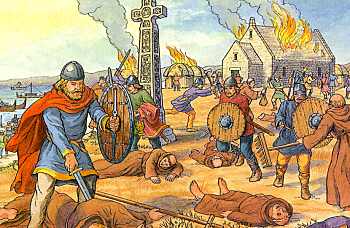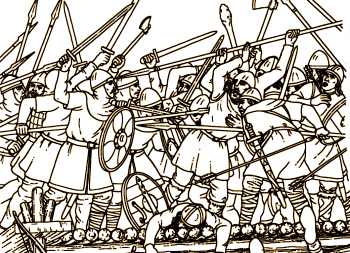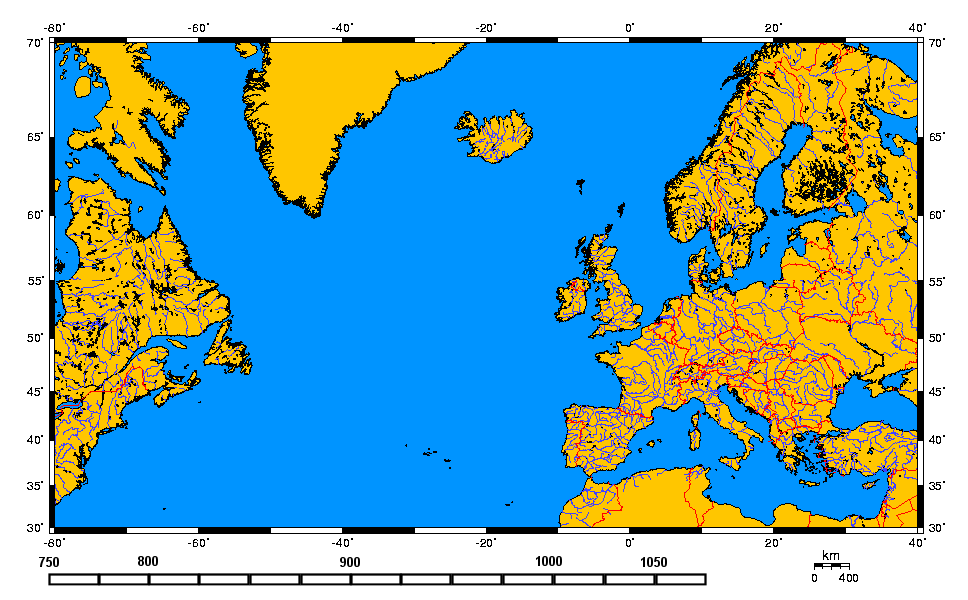
|

|
Norse Lands in the Viking Age
 |
The dates of the Viking Age are not clearly drawn, but many would consider the start to be the year 793 (the raid on the monastery at Lindisfarne, left) and the end to be the year 1066 (the battle at Stamford Bridge, right). During this time, the Norse people moved out of Scandinavia and exploded on the consciousness of Europe with their Viking raids. This article is a brief introduction to the lands occupied and influenced by the Norse people in the Viking age. |
 |
Prior to the Viking Age, Scandinavia had been occupied for millennia. As the glaciers retreated at the end of the last Ice Age, hunter-gatherers moved into the area. Farming and cultivation began in the area around 4,000 BCE. The working of bronze became widespread by 2,000 BCE, with the working of iron beginning around 500 BCE.
Artifacts from these early periods are extremely rare. Some of the best evidence comes from human sacrifices from the early iron age. The bodies and other offerings were deposited into peat bogs, and some of the remains and artifacts are very well preserved.
The end of the Roman era (circa 400) brought about the Migration Period in Europe, with mass movements of peoples throughout the continent. Scandinavia seems to have escaped most of those movements, other than the departure of the Angles and the Jutes to Britain. During this period, the power of organized chieftains, holding their power through military might, began to grow.
The Vendel period (circa 600-800) saw the continuing consolidation of power by local and regional chieftains. Large scale construction projects (such as the Danevirke rampart in southern Jutland) were constructed, suggesting the rise of regional kings.
In the 8th century, something happened in Scandinavia to cause these people to start moving out of Scandinavia into Europe. As they moved out they were looking for three things: new land to settle; new partners for trade; new victims for raids.
It's not clear what change might have trigger this movement. Some scholars have suggested that the Scandinavian lands became overpopulated. While the first son in the family was on the fast track to inherit the farm, subsequent sons needed to find their own land to farm. New land could be purchased if one returned home from a trading voyage or a raiding expedition with new found wealth and fame. Alternately, new land could be found abroad for those willing to relocate.
This explanation is unconvincing. Even at its most populous, it appears that Scandinavia was not very densely settled; more arable land was available during this period.
Whatever the trigger might have been, the outward movement was aided by the Viking ships, which had reached an advanced stage of development by the start of the Viking age. The ships made it possible for Norse people to travel greater distances carrying more cargo with a greater chance of arriving at their destination safely than other European ships of the time.
The interactive map below shows approximate extent of Norse settlement and influence during the Viking age. Norse occupied lands are shaded green. As the Norse people were assimilated into the local culture, the shading turns grey. Sites of important battles, raids, and other incursions are shown with a red starburst.

|
The data are broken up into 25 year increments. Move your mouse cursor over the timeline above to view the map for any quarter century period. |
In some regions, the Norse settlers were assimilated into the local culture. For example, in Normandy, the Norse settlers were never the majority. Economic and cultural ties with the Norse homelands faded, and over a few generations, the Norse settlers fully adopted a Christian French culture. Similar assimilation occurred in Russia. In other lands, the Norse invaders were violently and bloodily pushed out.
A striking aspect of the Viking age is the extraordinary homogeneity across the Viking lands. The Norse people in the Viking age had an identity that distinguished them from other Europeans. Norse language, clothing styles, art, and jewelry were remarkably similar from Greenland to the Baltic lands.
Changes in styles were communicated and adopted from one end of the Norse lands to the other in extremely short time spans. For instance, a major change to the runic alphabet was adopted throughout the Norse lands in less than a generation. New artistic styles, similarly, were quickly adopted. This rapid spread of new ideas suggests excellent communications between the Norse lands and widespread exchange of ideas and material objects.
The death of Haraldr haršrįši at the Battle of Stamford Bridge in 1066 is generally taken as the end of the Viking age. While other Viking raids occurred after this date, none of them had the intensity, the organization, or the chances for success of the earlier raids. In addition, the Scandinavians found themselves more and more as the victims of raids perpetrated by others. In particular, the Danes were troubled by Wendish raiders from the east.
The Scandinavian kings consolidated their power, and the Christian church exerted increasing influence. The forces that pushed the rest of Europe into feudalism were strongly felt in the Norse lands as well. The Viking Age was over.
|
|
©1999-2025 William R. Short |